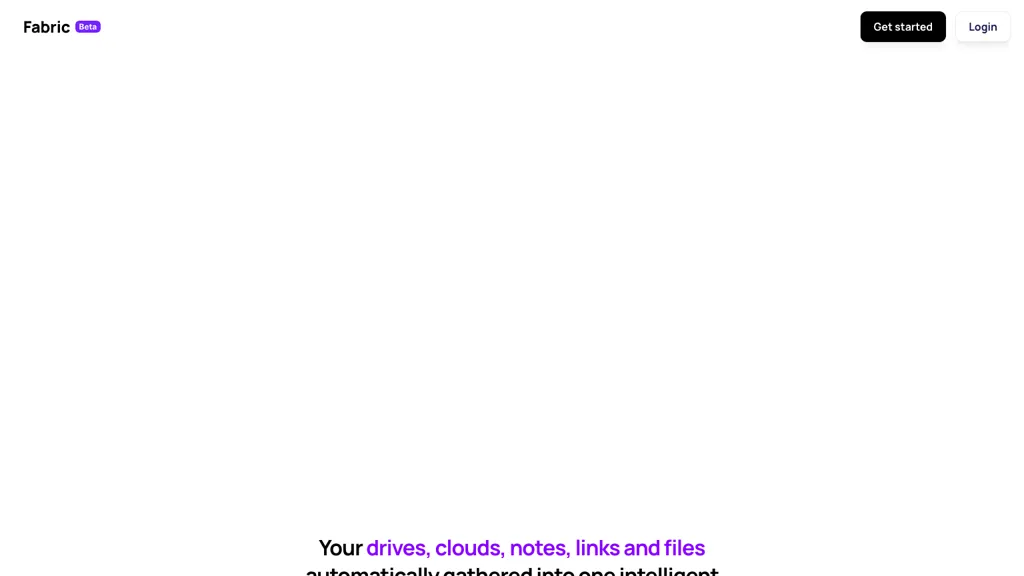What is Fabric?
Fabric Internet OS is an AI-native workspace where drives, clouds, notes, links, and files come together as one intelligent platform. With Fabric, users can find any information in a snap with natural language search and even talk to it. Fabric is a solution for individual and team workspace that can smoothly collaborate on files and documents.
Fabric enables users to gather inspiration, research notes, images, bookmarks, and more in one place. This significantly enhances productivity and collaboration. The platform interlinks various data sources using semantic search technologies that dispel users from manual organization work and enable focus on creativity and the dissemination of knowledge.
Key Features & Benefits of Fabric
Fabric provides a lot of features and advantages to the users in various domains, including but not limited to the following: natural language search, chat with data, file collaboration, document collaboration, collecting and organizing inspiration, notes, images, bookmarks, among others. Semantic search technology. These put together enhance productivity by seamlessly organizing and allowing the user to quickly access their information. Some of its unique selling propositions are that Fabric can integrate various data sources into a self-organizing data repository, enabling advanced searching to save time and enhance knowledge sharing.
Fabric Use Cases and Applications
Fabric is versatile and can be put to use in several ways:
- Having all your research notes, images, and bookmarks in one central place unites processes of gathering inspiration and boosting productivity with ease.
- Easy collaboration of files and documents with team members will make the process of communication smooth and will save time over project management.
- Capabilities for self-organization in this virtual workspace include natural language search to make sure that users save time by trying to locate certain information or data.
Those who will be able to benefit by using Fabric are knowledge workers, students, researchers, content creators, software developers, designers, and teams who want to be more organized and productive.
Using Fabric
Using Fabric is easy and intuitive. Here is a step-by-step guide:
- Create and log in to your account with Fabric.
- First of all, start connecting your drives, clouds, and other sources of data with Fabric.
- Use the intuitive interface to upload and organize your files, notes, links, and images.
- Leverage natural language search to find specific information quickly.
- Collaborate with team members by sharing files and documents within the platform.
For best practices, ensure your data is regularly updated and organized. Familiarize yourself with the platform’s search and chat functionalities to maximize efficiency.
How Fabric Works
Fabric works by making use of advanced AI and semantic search technologies. The platform systemizes the unrelated pieces of data coming in from a variety of different sources into order. When the users enter any query, Fabric processes it through natural language understanding models to provide the required result efficiently fast. This smooth workflow allows users to spend more time on their job rather than managing the data.
Advantages and Disadvantages of Fabric
Like any other tool, Fabric has its pros and cons.
Pros
- Data is organized in a functional manner
- Advanced search functions
- Collaboration functionality
- Data integration from various platforms
Possible Cons
- Steep learning for the first time users
- Too much reliance on the internet
User Reviews generally point towards how Fabric efficiently arranges data for its retrieval. However, some of the users mention that it becomes a little cumbersome to learn in the initial stages.
How Much Does Fabric Cost?
Fabric offers a variety of pricing plans that fit different needs. Although details may have changed, there is normally a free level to cover basic features, and other paid plans for more advanced capabilities. Overall, Fabric’s pricing is competitive with its competition, providing solid value in the advanced capabilities and integrations provided.
Conclusion about Fabric
In a nutshell, Fabric Internet OS is an AI-native powerhouse of a workspace. It enhances overall productivity and collaboration by aggregating all kinds of data in one place. Out-of-the-box and touting featured abilities like natural language searches and semantic technology, it’s sure to catch the gaze of target audiences from every walk of life. Though there might be a little learning curve, the pros outweigh the cons.
What to expect from future development-surely, it is about more integrations and making AI more powerful so that Fabric becomes an even more indispensable tool among knowledge workers and teams. If one looks for a way to rationalize his work and rise to a new degree of productivity, he definitely should try Fabric.
Fabric FAQs
What is Fabric Internet OS?
Fabric Internet OS is an AI-native workspace for drives, clouds, notes, links, and files on one intelligent platform, also complete with top-notch search and collaboration features.
How does Fabric enhance productivity?
Fabric enhances productivity by providing a place to house all data in one location, and retrieve it much quicker through natural language search and semantic technologies, hence concentrating on core tasks.
Is Fabric suitable for collaboration within teams?
Yes, Fabric allows easy collaboration in files and documents, team project work, and even communication within the team.
Which sectors does the usage of Fabric fit best?
The education, research, content creation, software development, and design industries are those that will most benefit from the use of Fabric.
Does Fabric have disadvantages?
On the other hand, some of the potential drawbacks in Fabric are a steep learning curve for beginners and dependency on internet connectivity in order to access a variety of interesting features.










